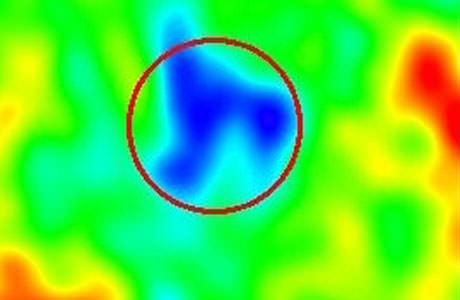Rats! Another perplexing space mystery solved by science. New analysis of the famous "cold spot" in the cosmic microwave background reveals, and confirms, actually, that the spot is just an artifact of the statistical methods used to find it. That means there is no supervoid lurking in the CMB, and no parallel universe lying just beyond the edge of our own. What fun is that?
Back in 2004, astronomers studying data from the Wilkinson Microwave Anisotropy Probe (WMAP) found a region of the cosmic microwave background in the southern hemisphere in the direction of the constellation of Eridanus that was significantly colder than the rest by about 70 microkelvin. The probability of finding something like that was extremely low. If the Universe really is homogeneous and isotropic, then all points in space ought to experience the same physical development, and appear the same. This just wasn't supposed to be there.
Some astronomers suggested the spot could be a supervoid, a remnant of an early phase transition in the universe. Others theorized it was a window into a parallel universe.
Well, it turns out, it wasn't there.
Ray Zhang and Dragan Huterer at the University of Michigan in Ann Arbor say that the cold spot is simply an artifact of the statistical method--called Spherical Mexican Hat Wavelets--used to analyze the WMAP data. Use a different method of analysis and the cold spot disappears (or at least is no colder than expected).
"We trace this apparent discrepancy to the fact that WMAP cold spot's temperature profile just happens to favor the particular profile given by the wavelet," the duo says in their paper. "We find no compelling evidence for the anomalously cold spot in WMAP at scales between 2 and 8 degrees."
This confirms another paper from 2008 also by Huterer along with colleague Kendrick Smith from the University of Cambridge who showed that the huge void could be considered as a statistical fluke because it had stars both in front of and behind it.
And in fact, one of the earlier papers suggesting the cold spot by Lawrence Rudnick from the University of Minnesota does indeed say that statistical uncertainties have not been accounted for.
Oh well. Now, on to the next cosmological mysteries like dark matter and dark energy!
Zhang and Huterer's paper.
Huterer and Smith's paper (2008)
Rudnick's paper 2007
Original paper "finding" the cold spot
Sources:
Technology Review Blog
,
Science
 Universe Today
Universe Today
